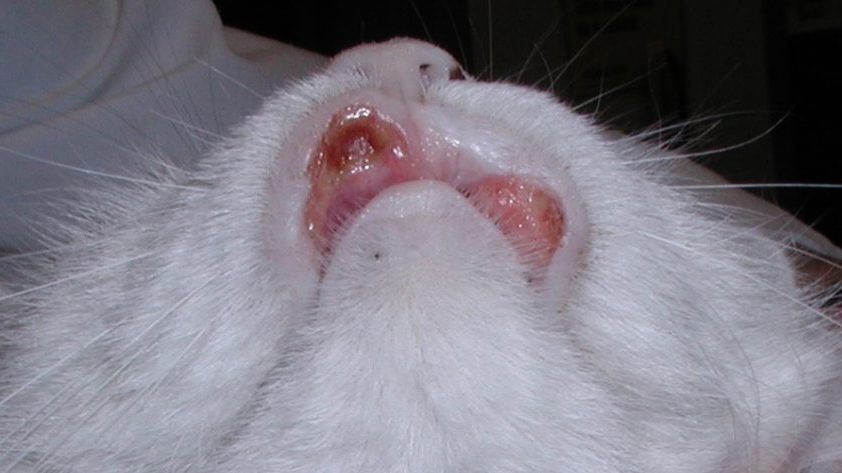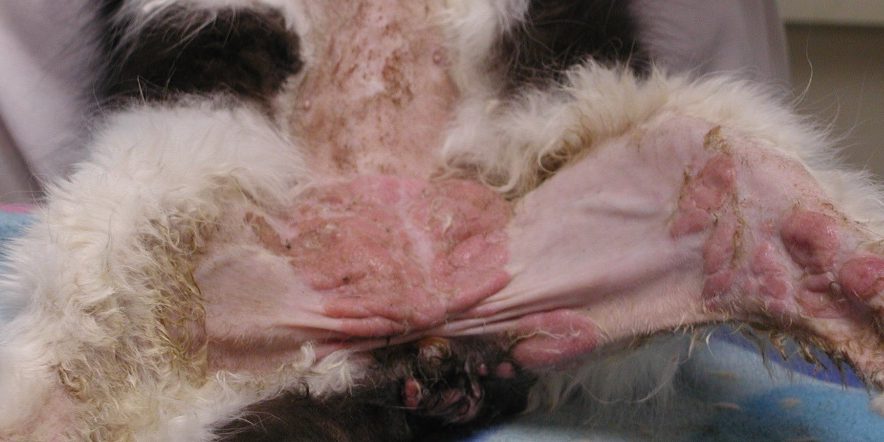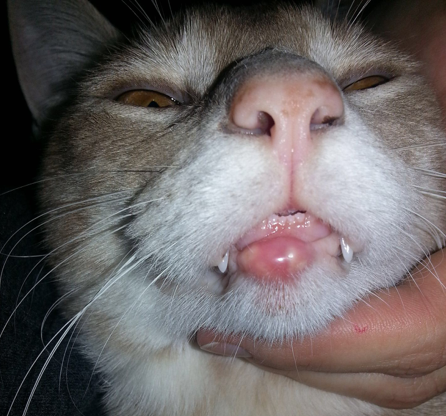17. Feline Eosinophilic Granuloma Complex
Learning Objectives
- Know! The eosinophilic granuloma complex constitutes a group of lesions, not a specific disease. Lesions can be present on different skin sites, on mucocutaneous junctions and in the oral cavity. Clinical presentation varies depending on the location of the lesion and type of the lesion. Three patterns of lesions have been recognized: the indolent ulcer, the eosinophilic plaque and the eosinophilic granuloma.
- Know! Some cases are associated with allergic conditions, bacterial infections and genetic factors and some are idiopathic. Look for an underlying disease and treat secondary bacterial infections. Resolving secondary infections can significantly improve, or even resolve, the indolent ulcer and eosinophilic plaque lesions.
- Know! All three lesion patterns have the characteristic of being recurrent, especially if an underlying triggering disease cannot be identified and effectively controlled. Some lesions can eventually become refractory to treatment.
- Know! The indolent ulcer lesion occurs on the upper lip and often span both sides but it can be unilateral.
- Know! Most eosinophilic plaques occur on the ventral abdomen and medial thighs. Lesions may be single or multiple and coalescing, and they may occur on other areas of the skin. Lesions often have an eroded or ulcerated surface and have variable sizes. Many cats with eosinophilic plaques have allergies (i.e. fleabite allergy, food allergy or atopic skin syndrome). Pruritus is a common sign, and it is usually severe.
- Know! Eosinophilic granuloma can develop on the skin, oral mucosa and mucocutaneous junctions. The clinical presentation varies depending on the site involved. The linear granuloma occurs often in cats less than 2 years of age and is characterized as a raised linear orientation on the caudal or medial aspects of the thigh. They are usually firm and have a yellow or pink color. They are often asymptomatic and can spontaneously resolve. Linear granulomas can also occur on the neck, thorax, lateral trunk and forearms. A second presentation of eosinophilic granuloma is individual or grouped nodular and/or ulcerated lesions. These lesions have diverse distribution including the footpads and trunk. Footpad lesions can become eroded and ulcerated and can cause lameness. Lesions of eosinophilic granuloma can develop in the oral mucosa and can be associated with anorexia, hypersalivation, problems with apprehension of food, and halitosis. Eosinophilic granuloma is the most common cause of feline lower lip swelling/nodules and asymptomatic swollen chin (fat-chinned cats).
- Know! The diagnosis of the eosinophilic granuloma complex is based on a detailed history and characteristic clinical signs. Skin biopsies are necessary if the clinical presentation is unusual and the index of suspicion for neoplasia (e.g. squamous cell carcinoma, mast cell tumor, lymphoma) and infectious granulomas (e.g. fungal, bacterial) are high. However, the histopathological findings associated with the eosinophilic granuloma complex are variable and non-diagnostic, but eosinophils should be an important part of the inflammatory infiltrate.
- Remember! Look for an underlying disease every time you diagnose a cat with lesions of the eosinophilic granuloma complex. Identifying and controlling the underlying triggering disorder helps prevent recurrences.
- Know! Glucocorticoids work well in most cases and are the first treatment option. Cyclosporine or oclacitinib can be used in cases that either do not respond or tolerate glucocorticoids. Gold therapy or chlorambucil should be the last option. Remember that these drugs may cause severe side effects requiring close monitoring of the patient. Some cases (mostly the eosinophilic plaques and ulcer) improve significantly or resolve on antibiotic suggesting that bacterial infection may play an important role in the development of these lesions at least in some cats.
-
General Considerations
- The eosinophilic granuloma complex constitutes a group of lesions that develop in the skin, mucocutaneous junctions and/or oral cavity of cats.
- Depending on the lesion type and body location, the disease can have variable history and clinical presentation.
- It is important to realize that the eosinophilic granuloma complex is nothing more than a skin reaction pattern, not a specific disease.
- Three lesions have been recognized:
- The indolent ulcer.

-
-
- The eosinophilic plaque.
-

-
-
- The eosinophilic granuloma, which can have various presentations (below is just one of the presentations).
-

-
-
- The most common primary disorders associated with these lesions are food allergy, environmental allergy (i.e. atopic dermatitis or feline atopic skin syndrome), or fleabite allergy.
- Bacterial involvement may be a factor in certain cases, because antibiotic therapy can markedly improve lesions, especially eosinophilic plaques and indolent ulcers.
- Lesions of the eosinophilic granuloma complex have been recognized in a colony of related, specific pathogen free (SPF) cats indicating a genetic cause in some cases.
- A triggering underlying cause is not always identified, and some cats may have a single episode of lesions.
- Uncommonly, the lesions of the eosinophilic granuloma complex will spontaneously resolve (e.g. linear granuloma).
- A cat may have all three lesion patterns (i.e. indolent ulcer, eosinophilic plaque, and eosinophilic granuloma) concurrently.
-
Important Facts
- It is important to realize that the eosinophilic granuloma complex is nothing more than a skin reaction pattern and not a specific disease.
- It includes a group of lesions that develop in the skin, mucocutaneous junction and oral cavity of cats.
- Depending on the lesion type and body location, the disease can have variable history and clinical presentation.
- Three lesions have been recognized including the eosinophilic ulcer, the eosinophilic plaque and the eosinophilic granuloma, which have various presentations.
- These lesions typically occur in association with a primary allergic disease, but they can rarely have a genetic cause or be idiopathic.
- Uncommonly, the lesions of the eosinophilic granuloma complex will resolve spontaneously.
- A cat may have lesions of indolent ulcer, eosinophilic plaque and eosinophilic granuloma, concurrently.

